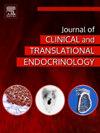基于机器学习的超声放射组学方法预测ptc的BRAF和TERT状态:一项多中心研究
IF 3.3
Q1 ENDOCRINOLOGY & METABOLISM
Journal of Clinical and Translational Endocrinology
Pub Date : 2025-03-30
DOI:10.1016/j.jcte.2025.100390
引用次数: 0
摘要
背景术前基因突变的识别有助于个体化治疗和管理甲状腺乳头状癌(PTC)患者。目的:探讨基于机器学习(ML)的超声(US)放射组学方法对PTC中BRAF V600E和TERT启动子状态(单独和共存)的预测价值。方法本多中心研究回顾性收集了2016年3月至2021年12月期间接受BRAF V600E和TERT启动子基因检测的1076例PTC患者的数据。从常规灰度超声图像中提取放射组学特征,选择与基因状态相关的特征。然后将这些特征纳入9种不同的ML模型,预测不同的突变,并进行最优模型加上具有统计学意义的临床信息。模型经过了训练和测试,并进行了比较。结果与其他8种ML模型相比,基于决策树的美国放射组学方法对BRAF V600E突变的预测效果更好,曲线下面积(AUC)为0.767比0.547-0.675 (p <;0.05)。采用Logistic回归的美国放射组学方法在预测TERT启动子突变方面表现出最高的准确性(AUC, 0.802 vs. 0.525-0.701, p <;0.001)和BRAF V600E和TERT启动子共存突变(0.805 vs. 0.678-0.743, p <;0.001)。临床因素的结合将BRAF V600E突变的预测性能提高到0.810,TERT启动子突变的预测性能提高到0.897,ptc双突变的预测性能提高到0.900。结论基于机器学习的美国放射组学方法,结合临床特征,可有效预测ptc中BRAF V600E和TERT启动子突变。本文章由计算机程序翻译,如有差异,请以英文原文为准。
Prediction of BRAF and TERT status in PTCs by machine learning-based ultrasound radiomics methods: A multicenter study
Background
Preoperative identification of genetic mutations is conducive to individualized treatment and management of papillary thyroid carcinoma (PTC) patients. Purpose: To investigate the predictive value of the machine learning (ML)-based ultrasound (US) radiomics approaches for BRAF V600E and TERT promoter status (individually and coexistence) in PTC.
Methods
This multicenter study retrospectively collected data of 1076 PTC patients underwent genetic testing detection for BRAF V600E and TERT promoter between March 2016 and December 2021. Radiomics features were extracted from routine grayscale ultrasound images, and gene status-related features were selected. Then these features were included to nine different ML models to predicting different mutations, and optimal models plus statistically significant clinical information were also conducted. The models underwent training and testing, and comparisons were performed.
Results
The Decision Tree-based US radiomics approach had superior prediction performance for the BRAF V600E mutation compared to the other eight ML models, with an area under the curve (AUC) of 0.767 versus 0.547–0.675 (p < 0.05). The US radiomics methodology employing Logistic Regression exhibited the highest accuracy in predicting TERT promoter mutations (AUC, 0.802 vs. 0.525–0.701, p < 0.001) and coexisting BRAF V600E and TERT promoter mutations (0.805 vs. 0.678–0.743, p < 0.001) within the test set. The incorporation of clinical factors enhanced predictive performances to 0.810 for BRAF V600E mutant, 0.897 for TERT promoter mutations, and 0.900 for dual mutations in PTCs.
Conclusion
The machine learning-based US radiomics methods, integrated with clinical characteristics, demonstrated effectiveness in predicting the BRAF V600E and TERT promoter mutations in PTCs.
求助全文
通过发布文献求助,成功后即可免费获取论文全文。
去求助
来源期刊

Journal of Clinical and Translational Endocrinology
ENDOCRINOLOGY & METABOLISM-
CiteScore
6.10
自引率
0.00%
发文量
24
审稿时长
16 weeks
 求助内容:
求助内容: 应助结果提醒方式:
应助结果提醒方式:


